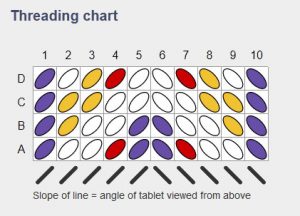Card weaving (also called tablet weaving) is a very ancient technique for weaving bands. It was used in Iron Age Europe as well as by the Vikings to weave headers for textiles woven on their warp-weighted looms.
Cards
 Cards (also called tablets) have a hole in each corner. One warp thread passes through each hole. Cards are usually 2.5-3.5 inches square.
Cards (also called tablets) have a hole in each corner. One warp thread passes through each hole. Cards are usually 2.5-3.5 inches square.
Materials you can use to make your own cards:
- playing cards
- cardboard
- thin plastic
- wood
- leather
How to make cards from playing cards:
- Cut the end off each playing card to make a square
- Round off the corners of each card so they don’t catch when you are weaving
- Punch a hole in each corner, about 1/2-3/4 inch in from the corner
- Label the holes on each card. Make sure the ABCD goes clockwise around the cards.
- Number each card so you know what order they are in.
Reading a threading chart
Each column represents one card and shows the colour of the four threads and which hole they go through.
One thread goes through each hole on the cards so you need four times as many threads as you have cards.
Planning your band
I recommend using colours with high contrast to start so it’s easy to see what’s happening while you weave.
If you want to make a band a particular length allow an extra 25% for takeup plus about another foot extra.
Winding a warp
You can wind all the warp threads of one colour together. For example, in this version of the pattern there are 12 blue threads, 8 yellow threads, 4 red threads and 16 white threads.
You can wind a warp using a warping board, around two C-clamps clamped to a table or around two chairs. It’s not necessary to make a cross while winding your warp unless you have a large number of threads. A cross is used to keep threads in order.
Once you have wound all your threads tie them together at one end with an overhand knot.
Threading your cards
Arrange your cards so they all have the backs facing right and the lettering you added facing to the left.
For each card thread the coloured threads through the corner holes according to the pattern. There are two different directions you can thread your cards. Look at the angled lines below the pattern on the threading diagram to see which way your cards should be threaded.
Thread each card, paying attention to the angle of the card and which holes the different colours go through.
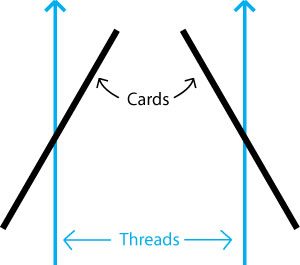
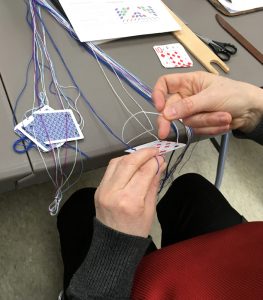
When you are done, pull on the threads to make sure there is even tension on them all and tie the loose end in an overhand knot.
Note about patterns and threading direction
The two different ways to thread cards are often labelled S and Z. However, some pattern authors refer to the angle of the threads and some refer to the angle of the cards. There is no universal standard!
When using a pattern make sure you understand which convention they are using.
Setting up to weave
Tie one end of your warp to a sturdy object like a doorknob, heavy chair, clamp on a table or even your toe. If your warp is too long, tie a knot in the middle and use a cord to tie the warp to something.
Take your dowel and stick it through the warp at the other end. Tie your backstrap or belt around your waist. Tuck each end of the stick through your belt. You should be sitting at a correct distance so that your warp is taut but not really tight.
Check the order and angles of your cards one more before you start to weave.
Wind some weft onto your shuttle. You can use a band weaving shuttle or you can wind your weft around a ruler. Use the same colour as on the outside cards so it will not show.
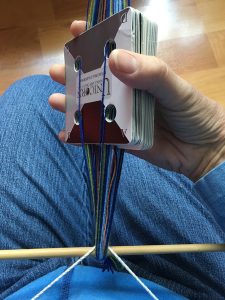
Weaving
The different sheds of the weaving are made by turning the cards forwards (the tops turn away from you) or backwards (the tops turn towards you). For each pick (row) of weaving we will make turn all the cards either forwards or backwards one quarter turn.
Insert thin pieces of cardboard, toothpicks or thicker waste yarn into the first 3 or 4 sheds to spread your warp threads out before starting to weave.
The order of weaving is:
1. Turn the cards
2. Beat the previous pick
3. Pull the previous pick’s weft tight. This is a warp faced weave so the weft is mostly invisible.
4. Pass the shuttle but don’t pull the weft all the way through – leave a small loop of weft hanging out
Start with the cards in position so that the A is on the top and closest to you and with the lettering on the cards facing to your left. Begin by turning the cards away from you so that the B is on the top and closest to you. Pass the weft. Do 4 forward turns this way followed by 4 backwards turns.
Here’s a video of Ann weaving during a workshop I taught recently.
Keeping Track
You must remember which way you are turning the cards as well as how many turns you have made. It’s easy to get distracted and forget where you are. Some ways to keep track of where you are in the pattern:
- Mark off each pick on a piece of paper
- Move pebbles (or Smarties) from one bowl to another
- Draw a big arrow on a piece of paper to show which way you are turning the cards.
If you need to stop weaving tie the cards together with a cord through one of the holes. I try to always stop at the end of one repeat.
Variations
Once you have woven this pattern for a while try some variations:
- Start your turns from a different position. Start with the B, C or D in the top position
- Try 6 forward turns followed by 6 backward turns
- Try 8 forward turns followed by 8 backward turns
- Try turning forwards only
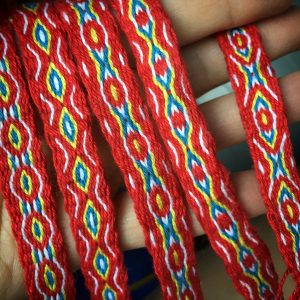
Troubleshooting
If the diagonal lines of your pattern don’t look smooth check your tablets. They may be angled the wrong way. Look at the underside of your band. if the underside looks good, turn your whole band over. Now the markings on your cards will be facing the other way but that doesn’t really matter.
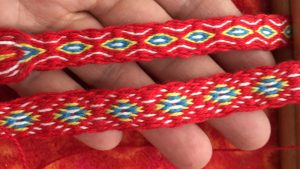
If your cards are angled the wrong way and you are using a simple pattern you may be able to flip them so that they face the correct way.
It’s inevitable that you will have to unweave after you make a mistake. Don’t despair.
Beginning and ending bands
You can lock the weft at the ends of your bands so they will not unravel.
When you start a band leave a tail of weft about 4-5” long after inserting the first pick. On the second pick pass your shuttle normally and also tuck the tail of the weft into the same shed. Do this on the next pick too.
To end a band first cut 3 pieces of thread in a contrasting colour about 6 inches long. On the next pick pass the weft as usual and then put in a loop of thread that hangs out both sides of the band with the open side facing the side the weft exited the band. Do the same on the next two picks. You will now have three loops of thread incorporated in the band with two facing one way and one facing the other way. Do one more pick with your weft. The weft should now be on the same side as the loop in the previous pick. Break off the weft with about 6” free. Thread the end of the weft through the loop in the previous pick. Then pull on the other end of this loop alll the way out which will pull the weft end back through the band. Do the same on the next 2 rows. Now you can cut off the weft without your band unravelling.
Wait, there’s more!
We have explored only one tablet weaving technique – threaded in patterns. There are many more techniques you can explore including patterns where some cards are turned forwards while others are turned backwards (like the pattern on the right), double-faced tablet weaving, brocade, patterns using 6 sided cards, patterns where one hole is left empty and others.
Resources
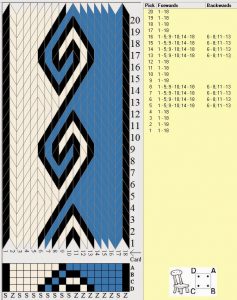 Tablet weaving software
Tablet weaving software
TwistedThreads.org is the best software currently. You need to make an account and you can only have a maximum of 30 patterns saved at one time.
Guntram’s Tablet Weaving Thingy (GTT) was already out of date in 2004 but may possibly run on your computer. You will see a lot of patterns created using this software on Pinterest. They look like the pattern on the right. The S or Z refers to the angle of the threads.
Web sites
John Mullarkey’s web site. He has two excellent Interweave videos about tablet weaving and he also sells cards, shuttles and books.
http://malarkycrafts.com/
Claudia Wollny’s excellent YouTube video Tablet Weaving Basics
Double Faced Tablet Weaving
http://www.housebarra.com/EP/ep05/09tablet.html
“Scutulis Dividere Gallia”: Weaving on Tablets in Western Europe
http://digitalcommons.unl.edu/cgi/viewcontent.cgi?article=1199&context=tsaconf
Books
The Techniques of Tablet Weaving by Peter Collingwood
Tablets at Work by Claudia Wollny
Card Weaving by Candace Crockett
Tablet Woven Accents for Designer Fabrics by Inge Dam
Articles and books on card/tablet weaving
https://www2.cs.arizona.edu/patterns/weaving/topic_tabletweaving.html
Tablet Weaving by Eva Sandermann Olsen
Includes some advanced techniques
https://evahaandarbejde.files.wordpress.com/2014/04/tablet_weaving_eso.pdf
A Tablet Weaver’s Pattern Book by John Mullarkey
Available as an ebook
https://malarky-crafts.myshopify.com/products/tablet-weavers-pattern-book-ebook-pdf
Where to find patterns on line
You can look at other people’s patterns or create your own on TwistedThreads.org
A collection of threaded in patterns from Guido Gehlhaar. The arrows indicate the angle of the cards – a left pointing arrow means a card angled like this \ and a right pointing arrow means a card angled like this /.
http://www.steinmaus.de/Mittelalter/weben/muster/schnurbindung/index_e.html
There are a lot of patterns on Pinterest

